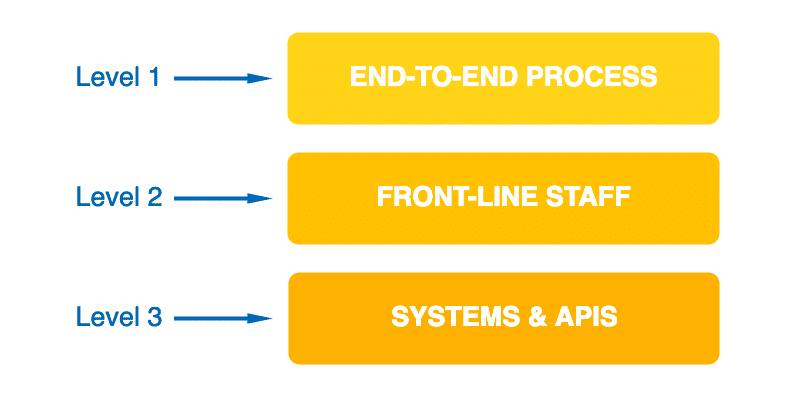
Getting on the front foot: A structured approach to Digital Process Automation
Last time we looked at how you can take a bottom-up approach with Digital Process Automation (DPA) to control your legacy systems. Now we’ll turn our attention to using it pro-actively — taking a top-down approach and creating a roadmap to completely revolutionise your processes.
Just as we are starting to see digital natives enter the workforce, we are also seeing a younger generation of business analysts and leaders exposed to Business Process Model and Notation (BPMN) in their education. So how do BPMN and DPA relate?
BPMN – the face of DPA
BPMN has a simplicity that belies its power. Starting with a few basic shapes easily sketched during whiteboard discussions, it can provide a precision that minimises misunderstanding. Given that the majority of us are visual thinkers, it is ideally placed to be the common language to bridge the gap between service owners (responsible business users) and technologists.
Whilst it is easy to draw shapes, it is imperative to have some structure for any process overhaul to get the best out of DPA.
Different organisations are, well, different. How you embark on your very first process automation journey will be different to how you evolve your approach when your confidence in the discipline grows.
Wherever you are on your understanding, what follows provides a good template.

Start with the ‘End-to-end’ view
The top process should describe a single value-chain (which we could describe as Level 1). In other words, from the time that a user starts trying to do something to the time they have successfully achieved it. The other aspect to a value-chain is that it’s abstract, it doesn’t go into every detail but just the key milestones. In particular, at this stage you should leave out any complexities introduced by unexpected events or having to go back around a particular loop.
Focus on your front line staff
Next, look at one stage of your end-to-end process, drill down into how that actually gets done. Look at the individual tasks that your people do. For example, “when we receive this, we need to do that”. Here you need to understand what happens when something goes wrong and if there is rework required.
This is your ‘Level 2’ process. You’ll have a whole collection of them each tackling one step in your value chain.
Depending on how complex Level 2 is, you may also want to push some of the details down into a Level 2b. For this introductory article, we don’t need to concern ourselves with that.
Look at how your systems contribute
Your front line staff probably have a whole range of systems and knowledge sources that they use to support their decision making. These may be databases and fulfilment systems that they have to update to perform part of a task or it could be offline systems such as a book of regulations or policies that they need to refer to know how to act in different circumstances.
The way these systems are integrated into what people do can be seen as Level 3 processes. If you’ve been reading since the first blog about legacy transformation and APIs, this is where it all comes together. These Level 3 processes are where we make use of those APIs. This is how DPA allows you to make legacy modernisation a practical proposition.
So that’s the approach. We’ve not gone into any details of BPMN but creating each of these three levels of process is a collaborative task very possibly done in front of a whiteboard and leans heavily on BPMN as our common language of all stakeholders.
Related content
-

Still entering data manually? Digitise & automate your systems
Published on: 3 March, 2020 -

What has digital government learned in the past year?
Published on: 18 December, 2019 -

Top five most viewed blogs in 2019
Published on: 1 December, 2019 -

Garbage-in/garbage-out: why data quality is critical to digital automation
Published on: 30 October, 2019
